Happy New Year!!! Chuc Mung Nam Moi!!!
Well, today is Lunar New Year's Day. Tet mong 1, and the festivities have begun. Actually, as of today, I have been off work for a week, but have blogged only sparsely because of the enormous amount of stuff to do to get ready for this holiday.
How can I best decribe it for those readers not Vietnamese.... it's like the Christmas holiday in America (six weeks of pagentry for one day) but crammed into two weeks of pagentry for four days. So, all total, the "feeling" of christmas is stronger for longer, but the four days of Tet are pretty unimaginable--and so are the days leading up to them.
Every family does a few things before Tet (which is the Vietnamese word for the Lunar New Year). First, they must buy flowers. Everyone buys flowers. They have HUGE flower fairs all over the city so people can by flowers to decorate their houses and give to friends. The two special flowers are Hoa Dao and Hoa Mai, but I will describe them later.
Second, everyone must go visit close friends and extended family, wishing them a good new year. You do this before Tet, and then during Tet also. During Tet, the tradition states that your luck for the coming year will be tied to the first person/family to visit your house, so typically a family will spend the first day with just immediate family and very close relatives. The second day will be for close relatives, and then gradually you visit people less closely related to you.
Third, everyone eats Banh Chung and Banh Tet. Both are eaten in north and south, but Banh Chung is associated with the north and Banh Tet with the south. A couple days ago, I went over to a cousin's place and helped make Banh Chung -- around 86 of them (43 pairs, give or take a few). This is how you make the tasty treat:
Here's the sight when I first got there about 10am.
 The whole family had been working since about 6 in the morning. Grandma and Grandpa watched as all the cousins worked together to make the banh chung in the front room while watching the Australian Open (Tennis rocks).
The whole family had been working since about 6 in the morning. Grandma and Grandpa watched as all the cousins worked together to make the banh chung in the front room while watching the Australian Open (Tennis rocks). Banh Chung is wrapped in large la dong (Phrynium leaves...don't ask me what that is) and so one person (a neice) is assigned to take the very large leaves and clip the tops to make them more square.

 Leaves are folded into a pretty ingenious wrapper--like origami with leaves.
Leaves are folded into a pretty ingenious wrapper--like origami with leaves. 
Leaves are pretty expensive. You buy about 100 leaves for 75,000 VND. Each "wrapping" takes 8 leaves, plus some little scraps at the end. So, 86 pieces use almost 700 leaves. In this case we bought 1000 leaves for about 750,000 VND.
The first thing that goes into the "box" is nep. That is translated as sticky rice. When it is boiled, it becomes very sticky, like a paste, unlike gao, which becomes the regular rice westerners know after boiling. The rice is soaked a couple times in large vats before being thrown into the leaf-pouch.

The "cook" will take about a bowl and a half of rice (using the small asian ricebowls that they typically eat out of every meal) and pack it down tightly into the bottom of the leaf-wrapper.

Nep is pretty cheap, usually about 10,000 VND per kilo.
 Next is added a block of dau xanh voi thit heo (mung bean with pork).
Next is added a block of dau xanh voi thit heo (mung bean with pork).  It is created in a long process. First, the mung bean, bought from the store,
It is created in a long process. First, the mung bean, bought from the store,  is boiled for about an hour in a pot that looks like this:
is boiled for about an hour in a pot that looks like this:  Then, the mung beans are transferred to a pot where they are mashed over and over again.
Then, the mung beans are transferred to a pot where they are mashed over and over again. 


 Once they are mashed into a good, dry paste, they are rolled into fist-sized balls for easy use out in the front room.
Once they are mashed into a good, dry paste, they are rolled into fist-sized balls for easy use out in the front room.  Out in the front room they sit in a bowl. One is picked up and mashed into a wooden frame with Saran wrap lining it (one of those quirky old meets new things ubiquitous to Vietnam).
Out in the front room they sit in a bowl. One is picked up and mashed into a wooden frame with Saran wrap lining it (one of those quirky old meets new things ubiquitous to Vietnam). 
 The Pork is then added (about two pieces) in a layer on top of the mung bean, and more mung bean is pressed down on top to form the brick shown earlier.
The Pork is then added (about two pieces) in a layer on top of the mung bean, and more mung bean is pressed down on top to form the brick shown earlier. Mung beans are actually more expensive than pork right now. Enough mung bean for all our cakes cost about 550,000 VND. The pork was far less than that. Even with the leaves at 750,000 VND and the mung bean at 550,000 VND, those two ingredients plus the pork and rice came out to only about 2,000,000 VND total for about 100 cakes. That's only 20,000 VND a cake (about $1.30 USD), and far less than the 70,000 VND they sell for in the stores.
 Once the mungbean/pork mixture is pounded into a brick, it is flipped into the leaf-wrapper on top of the rice. Then another bowl of rice is thrown on top and pressed down firmly--especially into the corners and sides around the mungbean brick--on top. That is the final layer of banh chung.
Once the mungbean/pork mixture is pounded into a brick, it is flipped into the leaf-wrapper on top of the rice. Then another bowl of rice is thrown on top and pressed down firmly--especially into the corners and sides around the mungbean brick--on top. That is the final layer of banh chung. 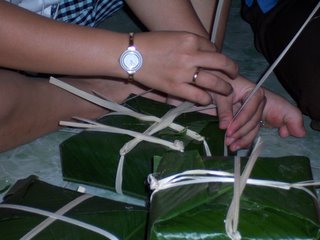 To seal the cake, the outstretched leaves from the original leaf wrapper are clipped at the tops and folded over just as if you were wrapping a christmas present. Carefully, the cake-maker holds the seams firmly while taking a piece of reed (basically free--thrown into the price of the leaves) and wraps it around the cake.
To seal the cake, the outstretched leaves from the original leaf wrapper are clipped at the tops and folded over just as if you were wrapping a christmas present. Carefully, the cake-maker holds the seams firmly while taking a piece of reed (basically free--thrown into the price of the leaves) and wraps it around the cake.  After two reeds are tied, the cake is passed to a designated "wrapping-person" who ties three reeds in each direction to achieve ....
After two reeds are tied, the cake is passed to a designated "wrapping-person" who ties three reeds in each direction to achieve .... ...the finished product!
...the finished product! 
Yet all is not done. Now comes the cooking. Here's a pic of most of our cakes.
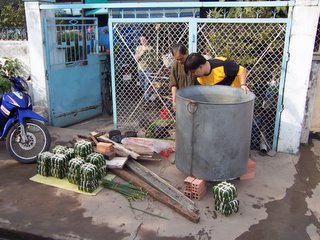 The cakes are taken outside and loaded into a large drum.
The cakes are taken outside and loaded into a large drum. 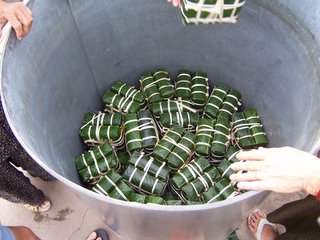 The drum is raised on bricks to allow a fire underneath and the bottom of the drum is filled with the scraps from the leaves.
The drum is raised on bricks to allow a fire underneath and the bottom of the drum is filled with the scraps from the leaves. 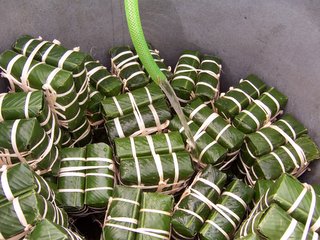 Slowly, each pair of cakes is set inside the drum in concentric circles until all 43 pairs are sitting snuggly in their cooking-place.
Slowly, each pair of cakes is set inside the drum in concentric circles until all 43 pairs are sitting snuggly in their cooking-place.  Then the water is turned on until the drum is filled over the banh chung.
Then the water is turned on until the drum is filled over the banh chung. 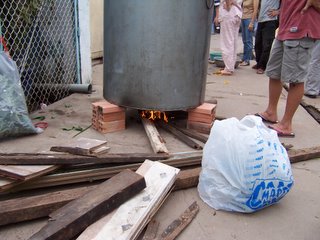 A fire is lit underneath the drum and once the water starts to simmer the lid is put on top and the banh chung starts to cook.
A fire is lit underneath the drum and once the water starts to simmer the lid is put on top and the banh chung starts to cook.  Thirteen hours of boiling later the fire will be extinguished, the top taken off carefully with a long pole (because the steam will burn anyone in a two foot vicinity) and the banh chung extracted and given to people to eat.
Thirteen hours of boiling later the fire will be extinguished, the top taken off carefully with a long pole (because the steam will burn anyone in a two foot vicinity) and the banh chung extracted and given to people to eat. Here's what my banh chung look like when finished.

So, this Tet or next, if you have the ability to eat some banh chung, go for it! It's often eaten with leeks or hot sauce. Happy eating!








2 comments:
Hi , I am Malaysian and love to read this article you post here!
Besides Banh Chung, what gifts I can give to my friends and family for Vietnam New year or you call it as..?I forgot.
Besides, any advices for dinner meal menu for vietnam that eat with rice?
I'm sorry I haven't responded to you sooner! Now the lunar new year has come and gone...
Traditionally, adults give people younger than them - especially children - "lucky money" in red envelopes. If you're giving gifts to the family, you can always give food such as bánh tết or new year's candy.
Dinner consists of eating the bánh chưng or bánh tết with pickled leeks. Some fry them. Some add hot sauce. Also, thịt kho nước dừa (pork and hard-boiled eggs boiled in coconut juice) is another traditional dinner.
New Years is a time for family. The first day is spent with the immediate family. People often play gambling games. The second day they visit their close relatives, and so on. The first person to visit your house determines the luck for the upcoming year.
I hope these tips help for next year!
Post a Comment